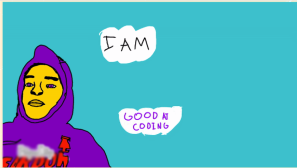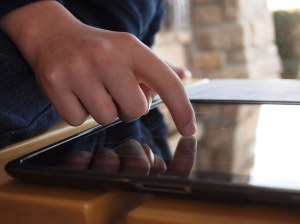tutoring
Where the Light Travels: Creative Media Builds Confidence and Digital Literacy

“Soon the digital divide will not be between the haves and the have-nots. It will be between the know-hows and the non-know-hows.”
– Stanford lecturer Howard Rheingold
Where the Light Travels is an after-school enrichment class designed to integrate photography and digital media into core areas of learning such as English Language Arts and Social Science. This project supports refugee youth in San Diego, creating engagement and connection by bridging hands-on creativity with technology and art.
The need for technology and visual communication has never been more important. This was highlighted as the world was sent into isolation with the impacts of COVID-19. “We use digital photos and videos to share our understanding, to connect with our communities, and to express ourselves,” stated Jana McBeath, Media Educator and Youth Council Coordinator with Outside the Lens. Receiving a three-year grant from the McCarthey Dressman Education Foundation is allowing McBeath’s project, Where the Light Travels, to transform an elementary after school digital media class into a safe space to build confidence while increasing digital and media literacies. She has seen firsthand how having media skills to use in life can change a student’s focus from self-identity, to family, community and eventually become a new language to use worldwide.
What were the goals of the project and how were they achieved?
Where the Light Travels was implemented virtually in partnership with the San Diego Refugee Tutoring Program as an after-school class with goals to:
- integrate ELA and core academic subjects using photography, videography, animation, and mixed media
- build confidence and engagement in students and their academic subjects
- create a safe space to encourage storytelling, identity and creativity
- showcase projects at a community exhibit honoring student work from throughout the year
Craft boxes with various art supplies and props were provided, as well as sealed envelopes with project materials. iPads loaded with apps for animation, photography, digital art, film editing, and other resources were also given to each student. To help combat screen fatigue, now that all of the students were learning online every day, the focus of the projects relied on the incorporation of tactile and hands-on activities, even though the project was designed to enhance digital literacy.
Consistent engagement became one of the major components of success. This was achieved in many ways. In addition to opening the sealed project envelopes online together each week, an emphasis was put on daily connection, using digital tools like Flipgrid and Google Chat for sharing jokes, art and ideas separate from the specific project.
Students were encouraged to experiment, explore and create in their free time in whatever interested them most and report back with self-directed projects. This was an opportunity to see what interested each student most, and reinforce the ELA and Skill standards in the discussion and evaluation of each student’s work. The consistent engagement, paired with the flexibility to adapt the curriculum to address varying curiosities, concerns and interests made the pivot to a virtual afterschool program arguably more successful than originally envisioned.
What progress did they make to their goals?

The projects created by the students really speak to the progress made in this program. The confidence of the students shines throughout and the results were far reaching. From comedic YouTube videos to dance performances and tactile science experiments, all of the projects incorporated some form of digital media problem solving, verbal and written communication, which addressed the crucial ELA, 21st Century Skills and digital media literacy needs.
What challenges were experienced along the way and what are the ideas for improving the project?
The onset of COVID-19 changed the goal for creative outlets to a necessity and was the biggest challenge for the project. What was meant to be an engaging in person experience now had to be redesigned to an accessible virtual setting that still allowed for meaningful connections for students who were already spending the day learning online. A lot of inventiveness went into pivoting this project to be something joyful for the students to look forward to during what ended up being a very difficult year for them in so many ways.
How has Where the Light Travels affected the learning of students and/or teachers?
Based on feedback from the students, parents, tutors and partners of the San Diego Refugee Tutoring Program, the effect on students was solidly positive. Engagement was achieved, as well as a returning student base. The students were truly able to nurture and develop their identity using their own passions and hobbies to explore interests and curiosities using the iPads and craft kits.
Exciting plans for the Future
As the project entered its second year, still virtual, the number of participating students doubled and included all previous students from the first year. Whether the program continues online, in person, or possibly even as a hybrid, the plans for the future include continuing with the student-led curriculum, utilizing techniques to stay highly adaptable, focus on mixed media projects, introducing advanced photographic processes, and keeping the asynchronous work and connections between classes.
Additional Resources
Learn more about supporting digital literacy for learners who are refugees:
Mariachi membership tunes up grades and turns on pride
Members of Tucson’s Mariachi Casabel Youth Organization take pride in new costumes and higher grades

Last year the McCarthey Dressman Education Foundation funded the Mariachi Cascabel Youth Organization (MCYO), an innovative program attempting to combine academics with community engagement using music, specifically Mariachi music, as the binding agent. With Tucson’s Sunnyside Unified School District’s diminished music budgets there didn’t seem to be much hope for the group, especially since they needed new costumes. For mariachi, image is just as important as musical ability. Their costumes, called Trajes de Charro, don’t come cheap, especially if you want quality and authenticity. Organizer Daniel Dong proposed a unique project for improving not only the image of the musicians but also their success in math and science. Funded in 2013 by the McCarthey Dressman Education Foundation, this unique and special music education program has already made an exceptional impact.
… students in arts-integrated classrooms are more creative,
engaged,
and effective at problem solving
than their counterparts who are not in arts-integrated classrooms.”
– Arts in Education Research Study, Kennedy Center ArtsEdge

Setting the tone for academic success
Research has indicated that students that who receive music education tend to do better, across the board, academically. This program takes it a step further by including a cultural component that has true community value. Daniel Dong’s idea was to help the Mariachi Cascabal Youth Organization Program, serving a primarily Hispanic district, be available to play in the community for all the most important celebrations. Even before funding they were able to play at a number of events including the Annual Latina Breast Cancer Conference and Mexican Mother’s Day festivals. He also coordinated within the school district to help MCYO get regular gigs at school carnivals and other related events.
Because within the district there is no other program like this, demand to get in is high. Here’s where the alignment with academics found a harmonious fit. The program instituted a requirement where students must retain passing grades or seek tutoring for those subjects. Now, not only were the students getting the benefits of a musical education, they were also more motivated to perform well in their other courses.
Costumes and instruments build pride, Tutors nurture brains
Because looking authentic was important for their success as legitimate mariachis within the community, the Foundation’s investment also went toward new costumes for the organization. They have currently received sixteen out of seventeen Trajes and are just waiting for the final jacket to come in to make their ensemble complete. The funding also provided new instruments for the group including two Prelude Violins, two Michoacána Vihuelas and four Yamaha Guitars from a local music company. Furthermore, students received three digital video cameras from Walmart to help document their experiments with the MCYO.
While a couple of students have fallen behind in their other academic courses, the tutors in math and science that have been provided are helping them reach their academic goals. In September, they held a large parent meeting to inform students and parents of all the benefits students receive by being involved in the MCYO. The prospects laid out got many parents excited which in turn helps the students realize the value of such a program.

There were, as always, some unexpected but not insurmountable costs. Trajes wear out quickly and they found they needed to bring their tailor up from Mexico City to do the measurements to make sure they got the highest quality Trajes. The Trajes were completed and shipped back to America in late April.
Culturally relevant music education and tutoring add up to better grades
From the beginning, the educators responsible for this project saw the value of a tutor. While the students were less than happy, initially, about being required to attend tutoring and a few stopped coming due to the requirements, many of those students returned and participated in the tutoring and watched their grades improve – a win for everyone involved.
Project educators also reported on how they could improve on this project for the next school year. Though they noted how enthusiastic parents were about tutoring, they couldn’t help but acknowledge how adverse the students were to it. They discussed ways to better sell that idea to students, so that this program and others patterned after it would find a lot more success. There were also important considerations that could be fine tuned in the future, such as streamlining the auditions, assessment of initial abilities and tutoring placement procedures.
Anecdotally, Daniel Dong reported, one of the biggest challenges was procuring the Trajes, which took about six months to obtain. Because they were authentically handmade in Mexico, however, the time was worth the wait.
All in all, the MCYO has been successful with their approach to using music education and tutoring to improve student success and creativity. They are on track to meet and exceed their proposed goal “to acquire mariachi outfits and musical instruments to help motivate students to be more engaged in their academics and to be positive role models in their community.”
What did the students have to say about their work?
MCYO members wrote about their experiences in the program and about attending the Tucson International Mariachi Conference.
Similar programs could be proposed in your other schools; take advantage of your local musical genres that impact your community the way that Mariachi music does in Tucson, Arizona, will be your real challenge.
For more information on the magic of music in academic enrichment, read on:
- Playing a musical instrument could boost brain function in kids (Digital Journal, 2014)
- Using Music in the Classroom to Inspire Creative Expression (Edutopia, 2014)
- New Evidence Links Music Education, Higher Test Scores (Pacific Standard, 2013)

